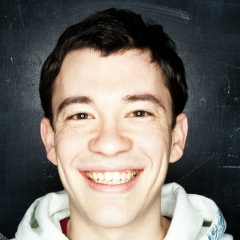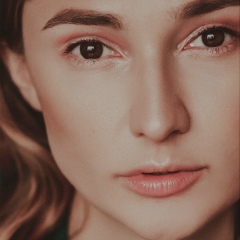Уважаемые коллеги!
В пятницу, 26 апреля 2013 г., в 15:00 в конференц-зале (2-й этаж) корпуса нелинейной оптики МГУ
(http://ilc.phys.msu.ru/about/contacts/) состоится лекция Проф. Алана Аспекта (Институт Оптики, Франция)
на тему "От интуиции Эйнштейна до квантовых бит: Новая квантовая эра?". Аннотация и постер лекции,
прилагаются.
Алан Аспект — французский физик, получивший всемирную известность благодаря своим экспериментам по
квантовому перепутыванию (quantum entanglement), нарушению соотношений Белла, лазерному охлаждению
нейтральных атомов и Бозе-Эйнштейновской конденсации. Алан — член Французской Академии Наук и Французской
Технологической Академии. В настоящее время — директоро по исследованиям CNRS. В 2005 г. он был награжден
золотой медалью CNRS, а в 2010 получил Wolf Prize.
Приглашаются все желающие!
From Einstein’s intuition to quantum bits:
a new quantum age?
Alain Aspect, Institut d'Optique, Palaiseau
In 1935, with co-authors Podolsky and Rosen, Einstein discovered a weird quantum situation, where particles in a pair are so strongly correlated that Schrödinger called them “entangled”. By analyzing that situation, Einstein concluded that the quantum formalism was incomplete. Niels Bohr immediately opposed that conclusion, and the debate lasted until the death of these two giants of physics.
In 1964, John Bell produced the famous inequalities that have allowed experimentalists to settle the debate, and to show directly that the revolutionary concept of entanglement is indeed a reality.
Based on that concept, a new field of research has emerged, quantum information, where one uses quantum bits, the so-called “qubits”. In contrast to classical bits, which are either in state 0 or state 1, qubits can be simultaneously in state 0 and state 1. Entanglement between qubits enables conceptually new methods for processing and transmitting information. Large scale practical implementation of such concepts might revolutionize our society, as did the laser, the transistor and integrated circuits, some of the most striking fruits of the first quantum revolution, which began with the 20th century.
Короткая биография
Aspect is a graduate of the École Normale Supérieure de Cachan (ENS Cachan). He passed the 'agrégation' in physics in 1969 and received his master's degree from Université d’Orsay. He then did his national service, teaching for three years in Cameroon.
In the early 1980s, while working on his PhD thesis[1] from the lesser academic rank of lecturer, he performed the elusive "Bell test experiments" that showed that Albert Einstein, Boris Podolsky and Nathan Rosen's reductio ad absurdum of quantum mechanics, namely that it implied 'ghostly action at a distance', did in fact appear to be realised when two particles were separated by an arbitrarily large distance (see EPR paradox). A correlation between their wave functions remained, as they were once part of the same wave-function that was not disturbed before one of the child particles was measured.
If quantum theory is correct, the determination of an axis direction for the polarization measurement of one photon, forcing the wave function to 'collapse' onto that axis, will influence the measurement of its twin. This influence occurs despite any experimenters not knowing which axes have been chosen by their distant colleagues, and at distances that disallow any communication between the two photons, even at the speed of light.
Aspect's experiments were considered to provide overwhelming support to the thesis that Bell's inequalities are violated in its CHSH version. However, his results were not completely conclusive, since there were so-called loopholes that allowed for alternative explanations that comply with local realism. See local hidden variable theory.
Stated more simply, the experiment provides strong evidence that a quantum event at one location can affect an event at another location without any obvious mechanism for communication between the two locations. This has been called "spooky action at a distance" by Einstein (who doubted the physical reality of this effect). However, these experiments do not allow faster-than-light communication, as the events themselves appear to be inherently random.
After his works on Bell's inequalites, he turned toward studies of laser cooling of neutral atoms and is now mostly involved in Bose-Einstein condensatesrelated experiments.
В пятницу, 26 апреля 2013 г., в 15:00 в конференц-зале (2-й этаж) корпуса нелинейной оптики МГУ
(http://ilc.phys.msu.ru/about/contacts/) состоится лекция Проф. Алана Аспекта (Институт Оптики, Франция)
на тему "От интуиции Эйнштейна до квантовых бит: Новая квантовая эра?". Аннотация и постер лекции,
прилагаются.
Алан Аспект — французский физик, получивший всемирную известность благодаря своим экспериментам по
квантовому перепутыванию (quantum entanglement), нарушению соотношений Белла, лазерному охлаждению
нейтральных атомов и Бозе-Эйнштейновской конденсации. Алан — член Французской Академии Наук и Французской
Технологической Академии. В настоящее время — директоро по исследованиям CNRS. В 2005 г. он был награжден
золотой медалью CNRS, а в 2010 получил Wolf Prize.
Приглашаются все желающие!
From Einstein’s intuition to quantum bits:
a new quantum age?
Alain Aspect, Institut d'Optique, Palaiseau
In 1935, with co-authors Podolsky and Rosen, Einstein discovered a weird quantum situation, where particles in a pair are so strongly correlated that Schrödinger called them “entangled”. By analyzing that situation, Einstein concluded that the quantum formalism was incomplete. Niels Bohr immediately opposed that conclusion, and the debate lasted until the death of these two giants of physics.
In 1964, John Bell produced the famous inequalities that have allowed experimentalists to settle the debate, and to show directly that the revolutionary concept of entanglement is indeed a reality.
Based on that concept, a new field of research has emerged, quantum information, where one uses quantum bits, the so-called “qubits”. In contrast to classical bits, which are either in state 0 or state 1, qubits can be simultaneously in state 0 and state 1. Entanglement between qubits enables conceptually new methods for processing and transmitting information. Large scale practical implementation of such concepts might revolutionize our society, as did the laser, the transistor and integrated circuits, some of the most striking fruits of the first quantum revolution, which began with the 20th century.
Короткая биография
Aspect is a graduate of the École Normale Supérieure de Cachan (ENS Cachan). He passed the 'agrégation' in physics in 1969 and received his master's degree from Université d’Orsay. He then did his national service, teaching for three years in Cameroon.
In the early 1980s, while working on his PhD thesis[1] from the lesser academic rank of lecturer, he performed the elusive "Bell test experiments" that showed that Albert Einstein, Boris Podolsky and Nathan Rosen's reductio ad absurdum of quantum mechanics, namely that it implied 'ghostly action at a distance', did in fact appear to be realised when two particles were separated by an arbitrarily large distance (see EPR paradox). A correlation between their wave functions remained, as they were once part of the same wave-function that was not disturbed before one of the child particles was measured.
If quantum theory is correct, the determination of an axis direction for the polarization measurement of one photon, forcing the wave function to 'collapse' onto that axis, will influence the measurement of its twin. This influence occurs despite any experimenters not knowing which axes have been chosen by their distant colleagues, and at distances that disallow any communication between the two photons, even at the speed of light.
Aspect's experiments were considered to provide overwhelming support to the thesis that Bell's inequalities are violated in its CHSH version. However, his results were not completely conclusive, since there were so-called loopholes that allowed for alternative explanations that comply with local realism. See local hidden variable theory.
Stated more simply, the experiment provides strong evidence that a quantum event at one location can affect an event at another location without any obvious mechanism for communication between the two locations. This has been called "spooky action at a distance" by Einstein (who doubted the physical reality of this effect). However, these experiments do not allow faster-than-light communication, as the events themselves appear to be inherently random.
After his works on Bell's inequalites, he turned toward studies of laser cooling of neutral atoms and is now mostly involved in Bose-Einstein condensatesrelated experiments.
Уважаемые коллеги!
В пятницу, 26 апреля 2013 г., в 15:00 в конференц-зале (2-й этаж) корпуса нелинейной оптики МГУ
(http://ilc.phys.msu.ru/about/contacts/) состоится лекция Проф. Алана Аспекта (Институт Оптики, Франция)
на тему "От интуиции Эйнштейна до квантовых бит: Новая квантовая эра?". Аннотация и постер лекции,
прилагаются.
Алан Аспект — французский физик, получивший всемирную известность благодаря своим экспериментам по
квантовому перепутыванию (quantum entanglement), нарушению соотношений Белла, лазерному охлаждению
нейтральных атомов и Бозе-Эйнштейновской конденсации. Алан — член Французской Академии Наук и Французской
Технологической Академии. В настоящее время — директоро по исследованиям CNRS. В 2005 г. он был награжден
золотой медалью CNRS, а в 2010 получил Wolf Prize.
Приглашаются все желающие!
From Einstein’s intuition to quantum bits:
a new quantum age?
Alain Aspect, Institut d'Optique, Palaiseau
In 1935, with co-authors Podolsky and Rosen, Einstein discovered a weird quantum situation, where particles in a pair are so strongly correlated that Schrödinger called them “entangled”. By analyzing that situation, Einstein concluded that the quantum formalism was incomplete. Niels Bohr immediately opposed that conclusion, and the debate lasted until the death of these two giants of physics.
In 1964, John Bell produced the famous inequalities that have allowed experimentalists to settle the debate, and to show directly that the revolutionary concept of entanglement is indeed a reality.
Based on that concept, a new field of research has emerged, quantum information, where one uses quantum bits, the so-called “qubits”. In contrast to classical bits, which are either in state 0 or state 1, qubits can be simultaneously in state 0 and state 1. Entanglement between qubits enables conceptually new methods for processing and transmitting information. Large scale practical implementation of such concepts might revolutionize our society, as did the laser, the transistor and integrated circuits, some of the most striking fruits of the first quantum revolution, which began with the 20th century.
Короткая биография
Aspect is a graduate of the École Normale Supérieure de Cachan (ENS Cachan). He passed the 'agrégation' in physics in 1969 and received his master's degree from Université d’Orsay. He then did his national service, teaching for three years in Cameroon.
In the early 1980s, while working on his PhD thesis[1] from the lesser academic rank of lecturer, he performed the elusive "Bell test experiments" that showed that Albert Einstein, Boris Podolsky and Nathan Rosen's reductio ad absurdum of quantum mechanics, namely that it implied 'ghostly action at a distance', did in fact appear to be realised when two particles were separated by an arbitrarily large distance (see EPR paradox). A correlation between their wave functions remained, as they were once part of the same wave-function that was not disturbed before one of the child particles was measured.
If quantum theory is correct, the determination of an axis direction for the polarization measurement of one photon, forcing the wave function to 'collapse' onto that axis, will influence the measurement of its twin. This influence occurs despite any experimenters not knowing which axes have been chosen by their distant colleagues, and at distances that disallow any communication between the two photons, even at the speed of light.
Aspect's experiments were considered to provide overwhelming support to the thesis that Bell's inequalities are violated in its CHSH version. However, his results were not completely conclusive, since there were so-called loopholes that allowed for alternative explanations that comply with local realism. See local hidden variable theory.
Stated more simply, the experiment provides strong evidence that a quantum event at one location can affect an event at another location without any obvious mechanism for communication between the two locations. This has been called "spooky action at a distance" by Einstein (who doubted the physical reality of this effect). However, these experiments do not allow faster-than-light communication, as the events themselves appear to be inherently random.
After his works on Bell's inequalites, he turned toward studies of laser cooling of neutral atoms and is now mostly involved in Bose-Einstein condensatesrelated experiments.
В пятницу, 26 апреля 2013 г., в 15:00 в конференц-зале (2-й этаж) корпуса нелинейной оптики МГУ
(http://ilc.phys.msu.ru/about/contacts/) состоится лекция Проф. Алана Аспекта (Институт Оптики, Франция)
на тему "От интуиции Эйнштейна до квантовых бит: Новая квантовая эра?". Аннотация и постер лекции,
прилагаются.
Алан Аспект — французский физик, получивший всемирную известность благодаря своим экспериментам по
квантовому перепутыванию (quantum entanglement), нарушению соотношений Белла, лазерному охлаждению
нейтральных атомов и Бозе-Эйнштейновской конденсации. Алан — член Французской Академии Наук и Французской
Технологической Академии. В настоящее время — директоро по исследованиям CNRS. В 2005 г. он был награжден
золотой медалью CNRS, а в 2010 получил Wolf Prize.
Приглашаются все желающие!
From Einstein’s intuition to quantum bits:
a new quantum age?
Alain Aspect, Institut d'Optique, Palaiseau
In 1935, with co-authors Podolsky and Rosen, Einstein discovered a weird quantum situation, where particles in a pair are so strongly correlated that Schrödinger called them “entangled”. By analyzing that situation, Einstein concluded that the quantum formalism was incomplete. Niels Bohr immediately opposed that conclusion, and the debate lasted until the death of these two giants of physics.
In 1964, John Bell produced the famous inequalities that have allowed experimentalists to settle the debate, and to show directly that the revolutionary concept of entanglement is indeed a reality.
Based on that concept, a new field of research has emerged, quantum information, where one uses quantum bits, the so-called “qubits”. In contrast to classical bits, which are either in state 0 or state 1, qubits can be simultaneously in state 0 and state 1. Entanglement between qubits enables conceptually new methods for processing and transmitting information. Large scale practical implementation of such concepts might revolutionize our society, as did the laser, the transistor and integrated circuits, some of the most striking fruits of the first quantum revolution, which began with the 20th century.
Короткая биография
Aspect is a graduate of the École Normale Supérieure de Cachan (ENS Cachan). He passed the 'agrégation' in physics in 1969 and received his master's degree from Université d’Orsay. He then did his national service, teaching for three years in Cameroon.
In the early 1980s, while working on his PhD thesis[1] from the lesser academic rank of lecturer, he performed the elusive "Bell test experiments" that showed that Albert Einstein, Boris Podolsky and Nathan Rosen's reductio ad absurdum of quantum mechanics, namely that it implied 'ghostly action at a distance', did in fact appear to be realised when two particles were separated by an arbitrarily large distance (see EPR paradox). A correlation between their wave functions remained, as they were once part of the same wave-function that was not disturbed before one of the child particles was measured.
If quantum theory is correct, the determination of an axis direction for the polarization measurement of one photon, forcing the wave function to 'collapse' onto that axis, will influence the measurement of its twin. This influence occurs despite any experimenters not knowing which axes have been chosen by their distant colleagues, and at distances that disallow any communication between the two photons, even at the speed of light.
Aspect's experiments were considered to provide overwhelming support to the thesis that Bell's inequalities are violated in its CHSH version. However, his results were not completely conclusive, since there were so-called loopholes that allowed for alternative explanations that comply with local realism. See local hidden variable theory.
Stated more simply, the experiment provides strong evidence that a quantum event at one location can affect an event at another location without any obvious mechanism for communication between the two locations. This has been called "spooky action at a distance" by Einstein (who doubted the physical reality of this effect). However, these experiments do not allow faster-than-light communication, as the events themselves appear to be inherently random.
After his works on Bell's inequalites, he turned toward studies of laser cooling of neutral atoms and is now mostly involved in Bose-Einstein condensatesrelated experiments.
У записи 3 лайков,
2 репостов.
2 репостов.
Эту запись оставил(а) на своей стене Константин Кудинов
























